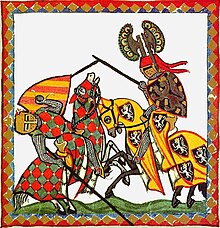Destrier
These forms themselves derived from the Vulgar Latin equus dextrarius, meaning "right-sided horse" (from dextra, "right hand", the same root as dextrous and dexterity).
For everyday riding, a knight would use a palfrey, and his baggage would be carried on a sumpter horse (or packhorse), or possibly in wagons.
They had powerful hindquarters, able to easily coil and spring to a stop, spin, turn or sprint forward quickly.
From medieval art, the head of the destrier appears to have had a straight or slightly convex profile, a strong, wide jaw, and good width between the eyes.
[16][17][18] During the important military campaigns of King Edward III in the middle of the fourteenth century, the increased demand for warhorses brought about considerable price inflation: in 1339 William de Bohun, 1st Earl of Northampton lost a destrier valued at one hundred pounds while on campaign in Flanders.
[19] Army muster rolls included detailed inventories of the warriors' horses: less than 5% of the warhorses were classified as destriers, owned only by a small elite of the wealthiest knights.
[20] However, because of destriers' relative scarcity and consequent infrequent sale and purchase, reliable price information for the period has not often survived.

